Every once in a while, I chase after intriguing stories that pique my interest. One of those stories is that of enigmatic Lt. Col. Adrian Simpson, mentioned in several Coldspur blogs. Simpson served with MI5 in B3 as a wireless expert for a brief time before moving on to serve with MI(R)in the Middle East.
I always like a good research challenge and decided to delve into the genealogy sites and see what I could dig up, if only to satisfy my own curiosity. The problem with a common name like “Simpson” is that the trail can very quickly get muddled. Fortunately, our friend Simpson’s full name was rather unique – “Adrian Francis Hugh Sibbald Simpson”. In the end, I have uncovered rather more than I expected and this blog post is therefore correspondingly long!
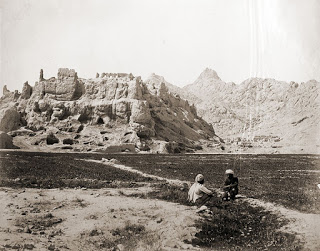
The Knighted Surgeon-General Photographer
We begin the tale with Benjamin Simpson and Agnes Jane Sarah Sibbald who were married in 1859 in Holy Trinity Church in Chelsea, London. Originally from Ireland, Benjamin was a doctor serving with the Bengal Army in India. Agnes had been born in India and after their marriage, the couple returned to India.
Benjamin would end up serving in the Indian Medical Service (Bengal) from 1853 to 1890. He was also a keen photographer and many of his photographs can be found online.
Benjamin and Agnes had at least five children:
- Agnes Frances Elizabeth Simpson – born 1862 in Patna, Bengal India
- Robert Ashley Simpson – born 1864 in Darjeeling, Bengal, India
- Percy Adolphus Simpson – born 1866 in Bengal, India
- Silvia Mary Florence Simpson – born 1869 in Bengal, India
- Adrian Francis Hugh Sibbald Simpson – born 8 October 1880 in Edinburgh, Scotland
Adrian was born twelve years after his youngest sibling (Silvia), and almost twenty years after his oldest sibling (Agnes). Less than a year later, in the 1881 census, Adrian was living at 7 Melville Street in Edinburgh with his mother Agnes (age 42), sister Agnes F.E. (age 18) and sister Silvia M.F. (age 12). The two older boys were likely away at school while their father was serving in India.
A few years later, Benjamin was appointed Surgeon-General of the Indian Medical Service and, on 15 February 1887, was one of the first individuals to be made a Knight Commander – Order of the Indian Empire (KCIE).
Benjamin retired from the Indian Medical Service in 1890 and by 1891, the family had moved to Weston-super-mare in Somerset. The 1891 census, however only lists Adrian and his mother.
By 1901, Adrian was no longer living at home, although his sister Silvia Renton was living with her parents at 72 Ashley Gardens, Hanover Square, London. The household also included five servants: housemaid, parlour-maid, cook, [indecipherable], and a sick nurse. It is likely that the sick nurse cared for Silvia who, although married, lived apart from her husband and young daughter and would pass away in 1905, a few months after securing a divorce from her husband (see Simpson Sideshoots section at bottom of this blog). But what had become of Adrian?
Adrian and the Indian Army
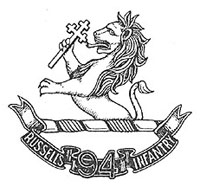
In the early 1900s, Adrian’s name appears in a number of London Gazette entries as well as British Army Lists. From these, we can piece together the rough shape of his military career. By 14 February 1900, Adrian was a Second Lieutenant with the Indian Staff Corps.
A few years later, on 12 December, 1902, Adrian was promoted to Lieutenant whilst serving with the 94th Russell’s Infantry in India (before 1903 was called the Hyderabad Contingent).
Whilst serving in India, Adrian was initiated into the Freemasons on 7 September 1905 and joined the Lodge Orion in the West (Poona Bombay).
Just two years later, however, on 9 March 1907, Adrian resigned from the Indian Army and apparently made his way back to England. That summer, Adrian married divorcee Monica de Wilton Roche (née Thackwell) Burrows in York.
From Soldier to Engineer
These are all rather dry facts and really don’t tell us much about the character of Adrian. We do know, however, that upon his return to England, Adrian studied wireless technology, for in later years he was associated with the Marconi Wireless Telegraph Company Ltd.
In 1911, Adrian became an Associate Member of the Institute of Electrical Engineers and in April of that same year, The Marconigraph (journal of the Marconi company) posted this notice:
Captain Adrian Simpson, late of H.M. Indian Army, has been appointed to the head office staff of Marconi’s Wireless Telegraph Co., Ltd., in London. (The Marconigraph – April 1911)
[N.B. If the Marconigraph pdf links don’t work – the documents can be downloaded direct from the Wireless World page of the American Radio History website.]
A few months later, the November 1911 edition of the The Marconigraph has this to say about Adrian and his role with the Marconi company:
In [Russia], and in the East generally, there is a big field for development, and in order to be thoroughly equipped to cope with the work in that vast territory we have secured the controlling interest in the Russian Company of Wireless Telegraphy and Telephony. This is a company which has been in existence for some two or three years, and is carrying out large contracts for the Russian Government, and are negotiating for further contracts of considerable magnitude with the Russian War Office, with the Marine, and with the Post Office. Captain Adrian Simpson, a member of our staff, in whose ability and integrity we have implicit confidence, has been appointed managing director of the Russian Company, and Mr. Marconi and I [Chairman – Godfrey C. Isaacs] are joining the board. Under Captain Simpson’s direction we are confident that a handsome revenue will accrue to us from this new field of action.
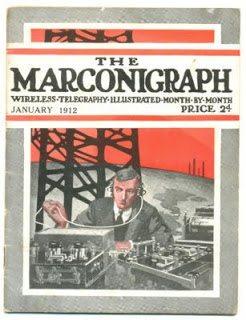
(From American Radio History site)
Finally, I came across a January 1912 edition of The Marconigraph journal which included a rather detailed biography of Adrian, confirming much of what we already know, but presenting the information as a story full of adventure and derring-do! I reproduce the article here in its entirety:
Adrian Simpson is a son of Surgeon-General Sir Benjamin Simpson, K.C.I.E., and was born in Edinburgh in 1880. His early years were passed amid the cultured and inspiring influences of his native city, whence he went to Clifton College [likely the one in Bristol] and then to the Royal Military College [Sandhurst]. Apparently he was destined for a military career, and shortly after the outbreak of the South African War [1899] he gained a commission in the British Army, being gazetted to the 31st East Surrey Regiment, then stationed in Lucknow [Uttar Pradesh, India]. After a short service with this regiment he joined the Hyderabad contingent of the Indian Army [former name of the 94th Russell’s Infantry]. This step marked the opening of a varied and interesting career which brought Mr. Simpson in touch with life in several countries and considerably enlarged his experience in dealings with men and the handling of affairs. He served first of all in the Bengal, Bombay, and Madras Residences; afterwards he was placed in command of a detachment of native troops in charge of one of the large camps in which were housed the Boer prisoners captured in the South African War; later he served on plague duty in Central India. He went to Russia in 1903 in order to learn that difficult language, and so proficient did he become in this subject that in the examinations for interpretership in the Army he gained the highest possible degree. Moreover, he obtained Government awards for proficiency in Persian and Hindustani and to the linguistic laurels which he gained by sheer merit and ability, must be added a knowledge of French. Mr. Simpson spent two years in Russia, and during that time he travelled extensively, his travels taking him from the Arctic circle to the Persian frontier. Indeed, the all-pervading wanderlust of the modern Anglo-Saxon seems to have absorbed him, for at various times he travelled in Cashmir, Finland, Norway, Sweden, Denmark, India, Russia, and elsewhere. In 1904, when the Armenian troubles were prevalent in the Caucusus [a reference to the Armenian–Tatar massacres (1905-1907)?], he succeeded in safely carrying the “Foreign Office Bag” from St. Petersburg to Tehran. He also realised that there was oil in the Caucusus as there was balm in Gilead, and he accordingly spent some months with a party of English engineers prospecting for oil in those regions.
In Mr. Simpson’s subsequent career we discern a peculiar trace of heredity in the combination of scientific and military practice [likely a reference to his father who combined a medical/scientific practice with a military career], although in the case of our subject it was the scientific practice that was superimposed upon an edifice of military training and travel. Leaving the service [1907 according to the Gazette] in order to make a thorough study of wireless telegraphy, Mr. Simpson commenced work with the English De Forest Wireless Telegraph Syndicate Ltd., and continued afterwards with the Amalgamated Radio Telegraph Co. Ltd. (owning the Poulsen Patents). During his service with the last named company he obtained an excellent opportunity of which he took full advantage of studying wireless telegraphy, not only as practised in England but also on the Continent where he spent considerable time in Berlin and Copenhagen, becoming subsequently associated with the Lepel Wireless Telegraph Co. Ltd. Mr. Simpson’s connection with Marconi’s Wireless Telegraph Co. Ltd., commenced with the Field Station Department, but on the formation of the Russian Company of Wireless Telegraphy and Telephony he was appointed managing director of that company. His unique experience, his commercial and technical attainments, his extensive travels, his linguistic ability, and, last, but by no means least, his knowledge of the language and people of that interesting country, encourage highest hopes for the success of his new enterprise, which all who know his kind and courtly nature, and his sound judgment and energy, are confident of seeing the happy realisation.
Mr. Simpson is an Associate Member of the Institution of Electrical Engineers and a member of the Anglo-Russian Chamber of Commerce. When a Royal Commission sat during 1910 to consider trade relations between Canada and the West Indies, Mr. Simpson gave evidence regarding the practicability of connecting the West Indies by wireless instead of cable.
It would appear that Adrian spent the next couple of years in Russia, managing the Marconi company’s interests. With the outbreak of the First World War, things got a bit more complicated.
First World War
According to the Electrical Engineers membership records, Adrian was listed in 1915 and 1917 as working for the Compagnie Russe de Telegraphie et Telephonie sans Fil, Lopuchiuskaja 14, Petrograd, Russia. This must be taken with a grain of salt as we shall see.
One of the Coldspur blogs references an author (Stephen Dorril) who noted that Simpson “had been ADC to the Grand Duke Nicholas in the Russian Army’s Caucasus ‘Savage Division’ “. Was that possible? It seems fairly clear from the 1912 Marconigraph article that Adrian spoke near-perfect Russian and was quite familiar with that “interesting” country. It is also clear that he spent time in Russia from 1911/1912 managing the Russian branch of the Marconi company. But did he serve with the Grand Duke Nicholas?
Confirmation of at least part of this claim comes from the medal card of Adrian (A.F.H.S.) Simpson (see below) which has a number of notations for his military service during the First World War. He is listed as an A.D.C. (Aide-de-Camp) with the War Office (with a rank of Major), as well as “Special Service” (rank of Major). Another layer of notation adds “CMG” and “Gen Staff” as well as “Lt Col”. He was apparently ineligible for the 1914-15 Star. A final notation simply states: “Russia 19-8-14” [likely 19 August 1914]. A notice in the Gazette has him as Temporary Captain Adrian Simpson from the General List effective 1 May 1915, although an earlier Gazette notice seems to indicate he may have been a Temporary Captain as early as 14 September 1914. This would seem to confirm that Adrian did indeed serve in a military capacity in Russia as an Aide-de-Camp.
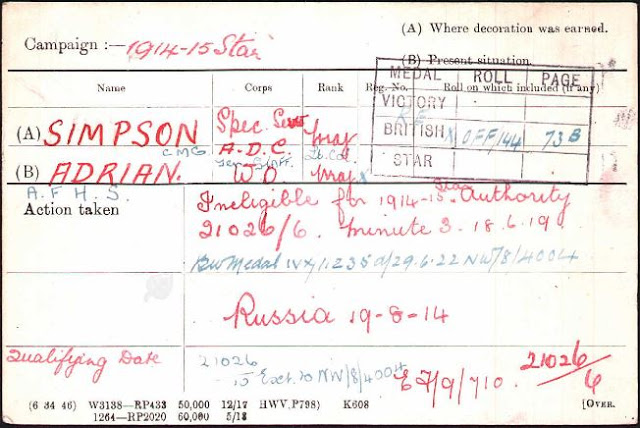
Additional information about Adrian’s military service in Russia can be found in a collection of photographs at the Imperial War Museum taken in 1915 by “Major Adrian Simpson”. While we can’t be utterly certain that this officer is identical with our Adrian F.H.S. Simpson, the convergence of facts (and further information below) would suggest that the likelihood is extremely high.
Photographs taken by Major Adrian Simpson whilst serving as a staff officer with Major General Alfred Knox, British liaison officer to the Imperial Russian Army, during the First World War. Images include:
-
- Russian infantry in trenches;
- transportation of Russian wounded;
- soldiers taking part in an Orthodox religious service in the field;
- men of a Tatar cavalry regiment;
- Grand Duke Michael Alexandrovich and his cavalry escort (possibly the photograph below);
- column of Russian artillery on the march; (possibly a photograph below)
- Russian military band and soldiers dancing;
- refugees from Warsaw during the German advance on the city in August 1915;
- British Red Cross motor ambulances in Russia;
- the Dimitri Palace in Petrograd (used a a military hospital);
- Russian medical staff and wounded in the Anglo-Russian hospital, Petrograd;
- the Fortress of St Peter and St Paul at Petrograd (full reference listed in Sources below)
While the Imperial War Museum does not provide thumbnail images of any of Adrian’s photographs, several are included in a 1915 edition of The Sphere magazine. The description of the photograph below (included in the text of the website) reads:
“with the Czar’s Brother in the Carpathians – by Captain Adrian Simpson – with portrait of Simpson and – – – group photo of officers of the Kabardine Regiment”.
This would suggest that Adrian is featured in the photograph but much of the text is too small to read.

“The Grand Duke Michael Alexandrovitch with Staff and Officers of the Kabardine Regiment. Among the group is included one of the priests, or mullahs, of the Caucasian Native Division as well as certain of the more influential of the Caucasian princes. (Thanks to Traugott Vitz for deciphering that line!) With the Czar’s Brother in the Carpathians by Captain Adrian Simpson, Acting A.D.C. to his Imperial Highness the Grand Duke Michael Alexandrovitch” (From The Sphere magazine – via Lord Durham Rare Books)
The photograph shown above was also reproduced in the Boston Sunday Globe on 15 April 1917 and includes a lengthy article which was reprinted from The Sphere magazine:
The following account of the command of the Grand Duke Michael, younger brother of the Czar, who refused the throne of the Romanoffs before it was really offered him, during the operations around Przemysl in the Spring of 1915 was written by Capt Adrian Simpson, who was then acting as his aid-de-camp, and is reprinted from the London Sphere:
Shortly after the commencement of hostilities the Caucasian Native Division, which was originally formed during the Japanese War, was reembodied. Recruited as it is from the wild mountain tribes of the Caucasus, it has since become famous under the title of “La Division Sauvage”…. [and the article continues]
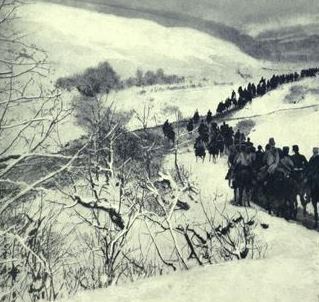
This photograph was taken by Captain Adrian Simpson, acting A.D.C. to the Grand Duke Michael Alexandrovitch, commander of the Caucasian Native Division, operating in Galicia. The troops are seen passing through a defile in the Carpathians and across a tributary of the River San.”
(From The War Illustrated Album DeLUXE – published 1915)
While Adrian served in Russia from 1914 to 1915, there is also strong evidence to suggest that he was part of the British Signals Intelligence unit, simply named MI1b (a predecessor of the Government Code & Cipher School). I’m not going to delve into MI1b into great detail and offer a few extracts which mention Adrian and provide some context:
Although the story told of British Signals Intelligence in the First World War focuses mainly on the work of Room 40 in the Admiralty, it was in fact MO5b (later MI1b), an intelligence section in the War Office which had the first success against German codes. This was largely due to the fact that the French, who had years of experience of Signals Intelligence against the Germans, were prepared to share all that they knew. (GCHQ (Government Communications Headquarters) website – The Story of Signals Intelligence 1914-2014)
We then skip to another section of the GCHQ website which presents the following information:
The army was given control of the air defence of Great Britain in June 1916 – until then responsibility had been untidily split between the Admiralty and the War Office with their respective Signals Intelligence organisations, Room 40 and M.I.1(b), both working against aircraft communications. As part of the new arrangements the areas of M.I.1 (b) responsible for wireless interception, direction finding (D/F) and traffic analysis were split off into a new section called M.I.1 (e), with support to air defence as its main operational task.
M.I.1 (e) was headed by Major Adrian Simpson [emphasis added], who at the outbreak of war was the managing director of the Marconi wireless company’s Russian subsidiary. After a period spent trying (largely unsuccessfully) to improve Russian communications and communications security he returned to Britain in 1915 and joined M.I.1 (b). Simpson was an enterprising character, as one of his officers recalled: “If he wanted something and the War Office refused it, he tried the Admiralty, who generally granted it to score off the War Office. If the Senior Service failed there was still the Air Force, or even the Post Office, which last he actually persuaded to put up three direction-finding stations at their own expense and to provide all the men to run them.” (GCHQ website – Defending our Skies)
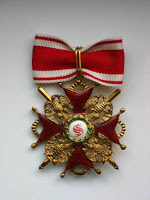
Finally, the London Gazette dated 9 March 1917 has the following note:
Decorations conferred by Field-Marshal
His Imperial Majesty the Emperor of Russia
Order of St. Stanislas, 2nd Class (with Swords)
Temporary Major Adrian Simpson, Royal Engineers, General Staff (November, 1915)
Order of St. Anne, 3rd Class
Temporary Major Adrian Simpson, Royal Engineers, General Staff (November 1915)
In 1917, Adrian received the Companion of the Order of St Michael and St George (CMG) “for valuable service in connection with the war”. He was listed as a Temporary Major with the Royal Engineers.
In November 1918, The Wireless World published an article entitled: Behind the Scenes in Russia: III – Adventures of a British War Correspondent on the Eastern Front. The article was written by Robert Wilton (Petrograd Correspondent of the “Times”) and mentions our friend Adrian. Whether Wilton could claim full credit for encouraging Adrian’s service with the Russians is another matter…
…I had had indirect relationship with the Caucasian Native Horse. A representative of the Viceroy (then Count Vorentsov-Dashkov) asked me if I could recommend some of our officers who had served with Indian cavalry regiments to join the new force. I mentioned this request to a friend in Petrograd, holding a high post in the wireless service, who had been a Captain in the Hyderabad contingent [likely Adrian Simpson]. It seemed to me an excellent method of bringing the Indian and Caucasian cavalry into personal touch with possible benefit to both sides. Through my humble intervention two British officers were able to serve with the C.N.H. for a few months: Captain (now Major) Adrian Simpson and Captain (now Colonel) John Kirkwood.
Thus it would appear that Adrian served with the Sauvage Division from 1914 to 1915 and then returned to England where he took up service with Room 40 of the British Signals Intelligence unit. Further confirmation of his may lie within records at the National Archives in Kew (see Untapped Sources section below).
Inter-War Period
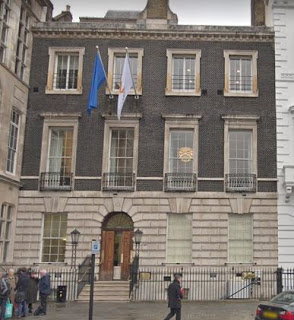
A year after the war, Adrian was back with the Marconi Wireless Telegraph Co., listed in the Electrical Engineers membership directory as: Lt. Col. Adrian Hugh F.S. Simpson R.E. C.M.G. c/o Marconi House, Strand, London.
By 1922, Adrian had risen through the ranks to become a Director of the company. While he was still listed as director in 1923 (the same year that his father passed away) and in 1925 (the same year that his mother passed away), by 1927, the Electrical Engineers membership lists have him associated with the Windham Club, 13, St. James’s Square.
Around the same time, Adrian was in the process of divorcing his first wife, Monica de Wilton Roche (née Thackwell) Burrows Simpson. [Monica later married Charles L. Wigan]. By the following year (1928), the divorce must have gone through for Adrian married Wanda Weiner (or Bychowetz) (born 28 November 1890) in the district of St. Martin, London.
That same year (1928), the British Oliver Typewriter Manufacturing Company was founded in England and one of the managing directors was Lt. Col. Adrian Francis Hugh Sibbald Simpson CMG, Royal Engineers of Wireless Pictures. Another managing director was Greville Richard Thursfield, of Igranic Electric, apparently an in-law of Adrian. [I have not been able to confirm that familial connection. It is not as simple as a sibling of Simpson marrying Thursfield.]
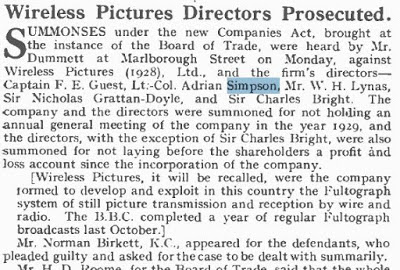
In 1930, the Electrical Engineers membership lists still had Simpson associated with the Windham Club at 13, St. James’s Square, London. Again, the membership lists need to be taken with a grain of salt, for an article published in The Wireless and Gramophone Trader journal (7 June 1930) indicates that Adrian was still connected with Wireless Pictures, at least as a member of the firm’s directors:
On 24 April, 1934, Adrian and his wife Wanda arrived at Southampton on the Asturias of the Royal Mail Lines Ltd. They gave their residential address as 1 Harriet Walk, Lowndes Street, London. Adrian was 53 years old and gave his occupation as “Colonel R.E. (ret)”. Although the ship originated in Buenos Aires, it made several stops along the way: Montevideo, Rio de Janeiro, Bahia, Madeira, Lisbon, Vigo and Cherbourg. According to the ship’s manifest, Adrian and Wanda boarded the ship in Vigo, Galicia, Spain. A 1935 London Directory lists Adrian [Lt. Col.] as living at 1 Harriet Walk (no mention of his wife).
Second World War
With the outbreak of war in early September 1939, the National Registration found Adrian and Wanda still living at 1 Harriet Walk, Lowndes Street, London. Their National Registration numbers were AFCN 110/1 [Adrian] and AFCN 110/2 [Wanda]. Wanda gave her occupation as “independent means” while Adrian was a “Lt. Col. R.E. attached General Staff”. His information had a line drawn through it with a note to “see p. 14”. That page simply lists his information again although his occupation is more difficult to decipher and almost looks like “attached W Central Staff”. Adrian and Wanda had a cook and a “domestic” but no children.
Despite the fact that Adrian was a Lieutenant-Colonel (retired), it would appear that wartime ranks were slightly different. A Gazette notice from 11 June 1940 notes that the “undermentioned to be Lts”:
5th May 1940 – Lt. Col. Adrian Francis Hugh Sibbald Simpson, C.M.G. (128956), late R.E.
A Gazette notice from 6 January 1941 notes that within the Intelligence Corps, “the undermentioned Lts. from Gen. List to be Lts. 15th July 1940, retaining their present seniority”, followed by Adrian’s name. It would therefore appear that although Adrian was a former Lieutenant-Colonel, his rank for the early years of the war was much lower.
The Coldspur blogs mentioned above have several references to Adrian’s time with section B3 in MI5’s B Division, which I will not repeat here. Interested readers are directed to those posts. Suffice to say that Adrian’s time within the ranks of B division was not all that long. Tony Percy at Coldspur suggests that by early to mid-1940, Adrian had left the ranks of B division. A bit of digging, and a rather circuitous route confirms this information.
A scanned document from CAB 102/649 has information on Adrian on page 69. My sense is that an OCR system was used to scan the document and had some trouble with the formatting of the document. The scan may not be entirely accurate as a result:
…objections also limited action in the Middle East before the Italian declaration of war, but M.I. (R) was in the field early with plans for raising the tribes in the Western Desert and in Abyssinia. Colonel Elphinston visited the Middle East more than once in the latter part of 1939, and eventually (in April 1940) Lt. Col. Adrian Simpson went out to form an “M.I.(R) Section” in H.Q. Middle East (later known as G(R)). This was an integral part of General Wavell’s H.Q., and M.I.(R)…
Having never come across M.I. (R), I did a bit of research and came across this post in the WW2Talk Forum:
The Military Intelligence (Research) (MI(R)) branch of the War Office was responsible for irregular operations and GHQ Middle East Forces had their own MI (R) initially commanded by Colonel Adrian Simpson. There was much infighting between G(R) and G(Operations) branch over control of units in the Middle East. G(R) branch was the controlling office for the cloak and dagger operations in the area.
Interestingly, Nigel West co-edited a book with Oleg Tsarev entitled Triplex: Secrets from the Cambridge Spies. Part IV is entitled NKVD Reports and includes Chapter 39 (Elena Modrzhinskaya’s Report, April 1943) which has a brief reference to Adrian:
…British intelligence created a special organisation to undertake espionage operations in the Caucasus. According to an informant, this is the Central Asian Bureau (an intelligence section set up among the staff of the British Armed Forces Middle East). Its head is said to be Colonel Adrian Simpson, who is based in Cairo.
Simpson was posted to Cairo in 1940 and tasked with running sabotage operations in the Caucasus to prevent oil being shipped to Germany…
One additional reference to Simpson comes from an article posted on an Italian site (apparently published 15 June 2002 in “Storia & Battaglie” (History & Battles)) which, with the questionable help of Google Translate, reads:
On June 29, 1940, at the suggestion of Col. Adrian Simpson, Major George A.D. Young, an engineer officer (Sapper) and former vice-commander of MIR (Military Intelligence Research) in the Middle East, formed the basis for the establishment of Commandos in the Middle East. Col. A. Simpson was one of the founders of MIR at the London War Cabinet along with Lt. Col. Joe Holland and Col. Sir Colin Gubbins, who would later become founder and head of SOE (Special Operations Executive).
The so-called “irregular” operations were then under the control and responsibility of MIR which was a section of the War Cabinet, but as the war theatre was very large, an MIR was also created at the Cairo headquarters. The task of organizing “irregular operations” in the Middle East was given to Col. Simpson, who thus became responsible for the “Bodies formed by irregular native in the territories under the control of the Axis”, and who, on 6 July, appointed as his deputy Captain Henry Fox-Davies (Durham Light Infantry).
In 1934 [is this date a typo?], during the annual maneuvers, he [Simpson? or Fox-Davies?] had already proposed to his commander to destroy “the opposing brain”, that is to strike the enemy command with a classic guerrilla operation.
This is how at the end of June 1940 the “LRDG” (Long Range Desert Group) was born under the control of MIR. Later in October [1940], the “Lybian Arab Force” (LAF) was formed under the command of Col. D.G. Bromilow and finally in August, October, November 1940 are formed respectively 50°, 51°, 52° Middle East Commando.
[N.B. I’ve tried to clean up Google Translate’s version a bit so that it reads slightly better]
All of this information suggests that Adrian had shifted away from being an advisor to B Division in early 1940 and become involved with Military Intelligence (Research) (M.I.(R)) and organized commando activities in the Middle East. A few other pieces of concrete information add a bit more to the picture.
A Gazette notice from 18 February 1943 notes that Major (Temporary Lieutenant-Colonel) Adrian Francis Hugh Sibbald Simpson C.M.G. (128956) Intelligence Corps (Ascot) was created an Officer (Military Division) of the Most Excellent Order of the British Empire (OBE). According to National Archives records (WO 373/76/455), Simpson received the OBE for service during the period of 1941 to 1943 in the Middle East (Egypt & Libya) as part of the Intelligence Corps. Adrian is apparently mentioned in another Kew file (WO 201/2864) which deals with Intelligence Organisation: MI(R) Middle East.
A further Gazette notice from 1 December 1943 notes that:
War Subs. Major A.F.H.S. Simpson (128956) from Corps was to be War Subs. Major.
This suggests that Adrian was transferred from the Intelligence Corps, but what became of him after that is a mystery.
After the War
There isn’t a lot of information to flesh out Adrian’s life after the war. We do know that on 3 October 1948, Adrian arrived in London onboard the Carthage, a ship of the P&O Steam Navigation Company Ltd. The ship had originated in Hong Kong but Adrian boarded in Port Said, Egypt. He gave his residence as 20 Chesham Place, London and his occupation as Retired Army Officer.
Another mention of Adrian is found on 19 February 1957, when he and his wife Wanda departed Liverpool aboard the Monte Arucas (Bahr Behrend & Co Ltd), destination Tenerife, Spain. The couple gave their address as 33 Chesham Place, London and Adrian was a retired army officer.
Adrian passed away on 2 October 1960 (80 years old) at Beaumont House, Beaumont Street, London. (Beaumont House had been rebuilt in the 1930s as a private hospital and after the war it became King Edward VII’s Hospital for Officers). Probate took place on 17 November to Wanda Simpson, widow, and Stanley Douglas Christopherson, Stockbroker. Adrian had effects valued at £73386 11s 8d.
There is no evidence that Adrian had any children by either of his two wives, although the census records would be the most helpful in that regard. The 1911 census lists Adrian and Monica living with a servant, but no children (they had been married four years at that point). The 1921 (and later) census records have yet to be released. The 1939 National Register has no children associated with Adrian and his second wife, Wanda.
Adrian Francis Hugh Sibbald Simpson had a most interesting life and it is a shame that his many contributions to the British war effort are not more well-known. I haven’t found a single portrait of Simpson, nor any “official” write-up of this fascinating officer.
Simpson Sideshoots
Brief notes regarding Adrian’s siblings and their descendants:
Agnes Frances Elizabeth Simpson – born 17 Dec 1862 in Patna, Bengal, India. Married Alfred Granville Balfour on 1 September 1886 in Simla, Bengal, India. They had at least three sons: John Edward Andrew Balfour (1887-1891), Major James Alfred Balfour 1st Btn HLI (1889-1917) and Lt. Commander Ronald Egerton Balfour RNVR (1897-1941). Brigadier General Sir Alfred Granville Balfour (former Commander Highland Light Infantry) passed away on 14 March 1936. His wife, Agnes, passed away two months later 12 May 1936 in Westminster. (See Postscript below)
Robert Ashley Simpson – born 24 July 1864 in Darjeeling, Bengal. No further solid information found. A Robert “Ashby” Simpson, born in India around 1865 is listed at Wellington College (Berkshire) in the 1881 English Census (likely him). There is a Robert A. Simpson in the 1901 Scotland Census born around 1863 – would require further investigation. No death date found.
Percy Adolphus Simpson – born 30 October 1866 in Bengal, married 20 November 1891 in Fyzabad, Bengal to Jessie Mary Henrietta Margaret Paterson. By 1911 living in Weybridge Surrey. Died December 1920 in Battle, Sussex. No children found.
Silvia Mary Florence Simpson – born 1869 in Bengal India and baptised 17 June 1869 in Upton Cum Chalvey, Buckingham. Married Captain William Gordon Renton (1859-1908) on 23 June 1896 at St. Margaret’s in Westminster, London. They had one daughter, Sylvia Ethel Renton (1898-1977). In 1901, little Sylvia Ethel was living with her father. Sylvia Ethel’s parents, Silvia and William, divorced on 3 January 1905 (petition 5412) and Silvia passed away on 12 June 1905. William passed away in 1908. In 1911, little Sylvia Ethel was living with Renton relatives. In 1924, Sylvia Ethel Renton married Ivor Matthews Hedley (1892-1956) and they had at least one child, Rachel Mary Hedley (1924-1986). Rachel married Richard Edward Cecil Law, 8th Baron Ellenborough (1926-2013) in 1953 and the couple had three sons, one of whom is Rupert Edward Henry Law, 9th Baron Ellenborough. Rachel Mary was later known as Baroness Ellenborough.
Postscript
It came as a bit of a surprise, at the end of all this, to find that Adrian Simpson had a rather convoluted relationship to the story of Josef Jakobs!
One of the members of Josef’s court-martial panel was Colonel Edward William Sturgis Balfour DSO OBE MC (Commander Scots Guards), the 9th Balfour of Balbirnie. Adrian’s eldest sister, Agnes Frances Elizabeth Simpson married Alfred Granville Balfour. A coincidence of names? Apparently not. Referring to the Peerage we find that this connection:
Colonel John Balfour (1811-1895) – 7th Balfour of Balbirnie had two children of note:
1. Edward Balfour (1849-1927) – 8th Balfour of Balbirnie
1a. Edward William Sturgis Balfour (1884-1955) – 9th Balfour of Balbirnie
2. Alfred Granville Balfour (1858-1936) – married Agnes F.E. Simpson
So Adrian’s brother-in-law, Alfred Granville Balfour, was the uncle of Edward William Sturgis Balfour who served on Josef’s court-martial. Oh what a tangled web…
Sources
Ancestry – records for births, marriages, deaths, probate, census, passenger lists, electoral registers, city directories, military records; membership records of electrical engineers
London Gazette – many editions
Grace Guides website – mentions 1922 AGM
Données financières historiques website – mentions 1923 and 1925 company information
British Medical Journal from 1923 – biography of Benjamin Simpson
Wikipedia. – some information on Benjamin Simpson and his photograph
Christie’s – auction site with a lot of photographs taken by Benjamin Simpson
British Empire site – piece on the 94th Russell’s Infantry
Imperial War Museum – Catalogue no. 2013-12-03 – collection of photographs taken by Adrian Simpson whilst serving in Russia
Lord Durham Rare Books – features a magazine entitled The Sphere from 1915 (War No. 40 edition) which includes some photographs taken by Captain Adrian Simpson.
The War Illustrated Album DeLUXE: The Story of the Great European War told by Camera, Pen and Pencil – Volume III – The Spring Campaign – 1915.
The Wireless World – article by Robert Wilson – Behind the Scenes in Russia: III.
England Spiel – scanned document of CAB 102/649
Daily Mail – 13 April 2017 – no mention of Simpson but has photographs of Long Range Desert Group (Middle East) from late 1940
Untapped Sources
Intelligence and National Security, Volume 32, 2017 – Issue 3: Military Intelligence during The First World War – p. 313-332 – ‘A shadowy entity’: M.I.1(b) and British Communications Intelligence, 1914–1922 by James Bruce [apparently mentions Adrian Simpson but online journal requires a subscription] Google Search lists the following preview snippet: “Since the opening months of the war Captain Adrian Simpson, … and the War Office, both Room 40 and M.O.6(b) worked against the wireless ..” Intriguing if anyone has a subscription to the online journal…
National Archives – WO 373/76/455 – file on Lt. Col. Adrian F.H.S. Simpson and his Middle East service that resulted in the award of the OBE.
National Archives – WO 201/2864 – file on MI(R) Middle East – related to Simpson
National Archives – WO 106/1141 – Improvement of Wireless Telegraph communication between Great Britain and Russia: Report by Capt Adrian Simpson – The Historical Journal (below) cites this PRO file as including a report by Captain Adrian Simpson, 19/02/1915 re: Russia.
National Archives – WO 106/1411 – cited in another book as containing a report from Adrian Simpson – given the similarity between the above PRO file number and this one, it could be a typo, although the 1411 file does contain correspondence from 1914-1915.
Book by Marina Soroka: Britain, Russia and the Road to the First World War: The Fateful Embassy of Count Aleksandr Benckendorff (1903-16); Routledge (2011). Reference is made on page 278 to footnote 247 which reads: “Adrian Simpson to Sir George Arthur, 06.11.1916, RA PS/PSO/GV/C/Q/995/2”. This was viewed via Google Books which does not show all pages. The archival reference is unknown.
The Historical Journal – Vol. 24, No. 4 (Dec 1981), pp. 885-906 – article by Keith Neilson – “Joy Rides’?: British Intelligence and Propaganda in Russia, 1914-1917” – Google lists “Adrian Simpson” as appearing in this article, the full text of which requires a subscription. Footnote #7 from the article apparently references: “‘Report by Captain Adrian Simpson’, 19 Feb 1915, PRO, WO 106/1141″.
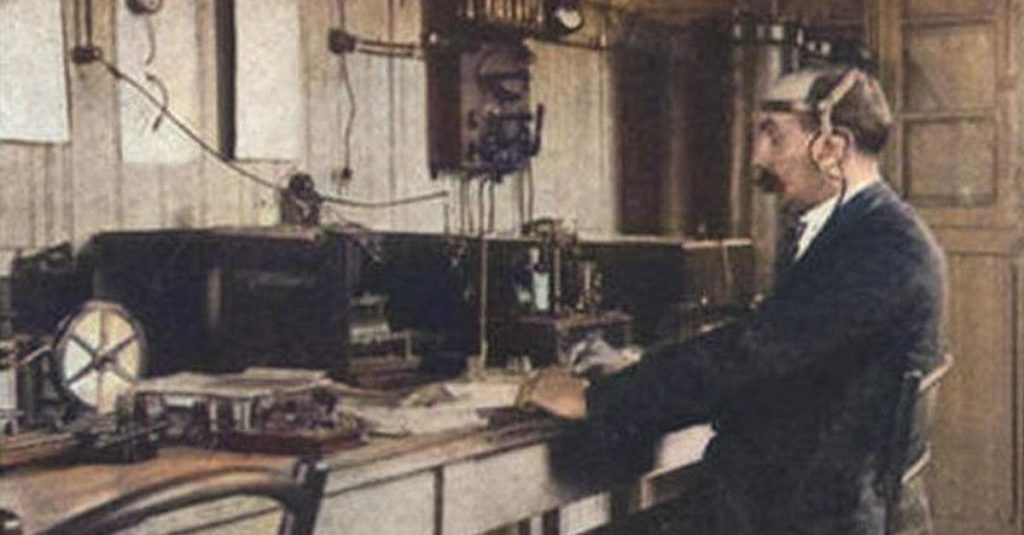
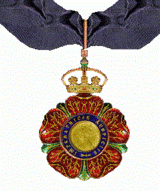
Very interesting. I went in search of more information on Adrian Simpson after reading about him on the Coldspur blog and was very pleased to find this.
Thanks Paul, appreciate the comment!